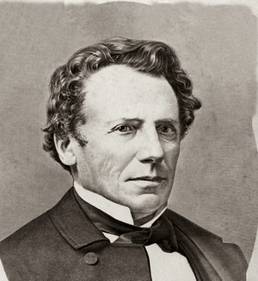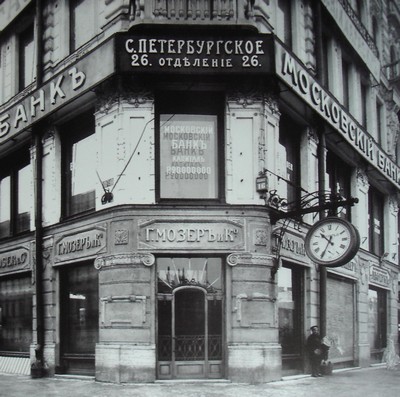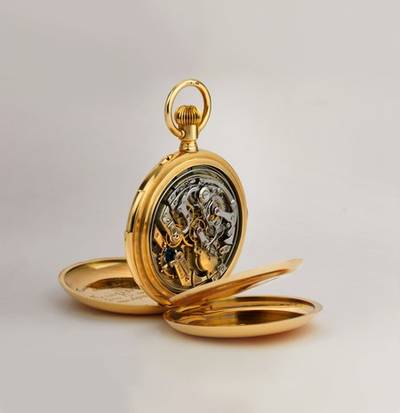In 1826, towards the end of his apprenticeship and a period spent as a journeyman, Heinrich Moser contemplated where and how he might build a successful future for himself. In fact, his aim was to introduce the manufactory method of working based on the principle of the division of labour in his home town of Schaffhausen, and to establish a small watch factory for this purpose. However, the Town Council at the time declined his proposal and awarded the honorary office of town watchmaker to another individual. Moser emigrated to St. Petersburg, in Russia, where he founded the trading company, “H. Moser & Co.”, at the end of 1828. From this company name, Moser also developed the company signature in cursive script, which was almost always supplemented by a medallion. Until about 1918, with rare exceptions, the company name in Cyrillic and/or Latin script, as well as the medallion, remained the standard signature on all the watches marketed by Moser's watch companies, whether sourced from its own production or from outside suppliers.

In 1829, he established a watch factory in LeLocle, which manufactured the pocket watches for his businesses in the European and Asiatic regions. By 1831, Moser was also able to open a branch in Moscow. Another astute business decision was the establishment of further branches in Nizhniy Novgorod and in Irbit – at the time the most important trade fair venues in Russia. The house of Moser thus had a presence in both of the Russian administrative centres, as well as at central trade fair venues.
Little by little, Heinrich Moser overtook the old-established businesses and its newer competitors. Within just a few years, he was selling watches to Japan and China, Persia and Turkestan, Siberia and Kamchatka. By around 1845, he had become the undisputed market leader in the whole of Russia, dominating the watch trade there. He had even established business links with Paris.
Moser's Russian enterprises at the time employed around 50 persons. Among them were German, Swiss, Russian and Swedish watchmakers. The names of the Swiss watchmakers, Johann Jakob Bär, G. Ganther, Johann Winterhalter, Victor Guye, Palk and Schwab, as well as Moser's son-in-law, Adolf Richard, are known from letters. An Italian, Bianco, is also mentioned. His most capable employee was undoubtedly J. Winterhalter, who subsequently took over Moser's company in Russia.

Even after Moser returned to Schaffhausen as a successful and wealthy businessman, he remained a passionate watchmaker at heart. He was aware from his training that, as far as pocket watches were concerned, case manufacture and quality often represented a weak point in the watch manufacturing process, and he opened a workshop with around 20 workers in Schaffhausen in 1853, where mainly silver watch cases were made. Three or four years later, he added a second workshop. In 1863, he equipped the workshops with completely new mechanical equipment, mostly to his own design, to facilitate case manufacture.
His only son, Henri Moser (1844-1923), showed little interest in the watch business, much to his father's displeasure. As a result, they went their separate ways in 1870. On the death of Heinrich Moser in 1874, his second wife, Fanny, inherited all his business interests and the watch factory in LeLocle. She had no desire to accept the responsibility, however, and in 1877 she sold the entire trading business to Johann Winterhalter and the watch factory in LeLocle to Paul Girard. In both transactions, she included conditions in the contracts to ensure that all the successor companies would continue to operate in perpetuity under the brand names of H. Moser & Cie. or Heinrich Moser & Co., in accordance with her husband's instructions. All of the enterprises passed into other hands in this way. The only son of Heinrich Moser, Henri, had no male offspring, and the name Moser also died out in this family.
In accordance with the contractual undertaking, the company name and the brand name remained unchanged, both in the global trade and in the watch factory at LeLocle. This situation continued until about 1917, when the Russian October revolution completely eliminated the watch market in the country that had been dominated by the Swiss watchmakers. The last of the Swiss Directors of the Moser company – Cornelius Winterhalter from about 1908 to 1918, and from 1910 to 1918 Octave Meylan – travelled back to Switzerland in early 1918, totally expropriated.
Around 1920, the State-owned “Central Watch Repair Workshop” in Moscow was formed from the remains of the Moser watch businesses, and between 1927 and 1930 a start was made on the establishment of its own watch production. Moser watches continued to be regarded as a synonym for work of the highest quality for some considerable time afterwards. As late as 1966, the USSR presented one of its high-ranking military officers with an original Moser pocket watch in 18-carat gold, dating from the period before the expropriation, with a specially engraved dedication. This watch is now owned by Moser Schaffhausen AG as a special contemporaneous exhibit.

Even after the take-over by the Girard family, the facility in LeLocle remained a production location for fine watches. It continued to adhere to Moser's philosophy of supporting the business on several pillars – pocket watches and wristwatches – and of working closely with the best suppliers. However, the Cyrillic script on the inside of the dust cover that had frequently been used until then was now omitted from the signature.
Information from 1953 points to an expansion in wristwatch production, and reference is made to a water-resistant 12-ligne watch and an 11 ½-ligne automatic watch, among others. H. Moser & Co. was also mentioned in 1973 as a manufacturer of precision lever escapement watches and special watches, predominantly in 18-carat gold and in cases set with precious stones.
In 1979, the watch factory in LeLocle became part of the “Dixi-Mechanique” Group and traded as “Hy Moser & Cie.”.
The original brand of the founder, “H. Moser & Cie.”, was once more registered internationally by Dr. Jürgen Lange in 2002. Moser Schaffhausen AG was launched jointly with representatives of the Moser family. Today the great-grandson of Heinrich Moser – Roger Nicholas Balsiger – is Honorary Chairman of the Board of Directors. The Company has returned to the international watch arena, in the autumn of 2005, to mark the bicentenary of Heinrich Moser's birth.

The new watches that have been developed by H. Moser & Cie. over the last three years add a hint of understatement to their traditionally classic/elegant appearance, and, entirely in keeping with the tradition of the establishment, utilize mechanical movements designed in-house and executed to the highest quality standard. It goes without saying that these movements, which incorporate a cornucopia of technical innovations and offer high customer benefit, can only be found in watches from H. Moser & Cie.
We have now come full circle, and, as the great-grandson expressed it so poignantly in an interview: “I find it very moving that we are now in a position to make Heinrich Moser's return to Schaffhausen as a watchmaker possible 200 years after his birth.”






